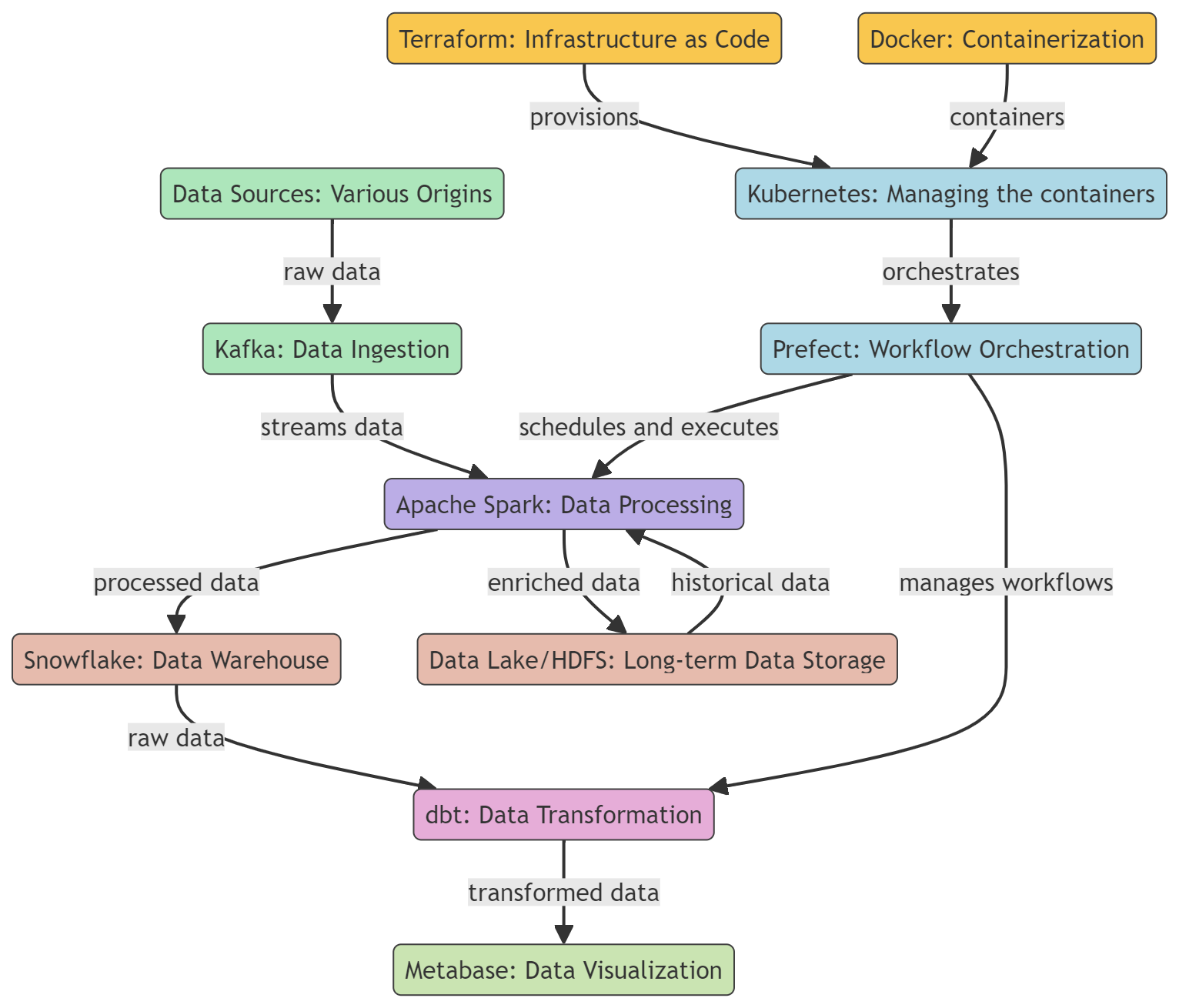Programa
Los ingenieros de datos son responsables de crear canalizaciones de datos que puedan ingerir, procesar y entregar datos a varios puntos finales, como bases de datos, almacenes de datos y plataformas de análisis. Al construir y mantener estos conductos de datos, los ingenieros de datos permiten a los científicos y analistas de datos acceder a los datos en tiempo real para el análisis y la toma de decisiones.
Se espera que los ingenieros de datos modernos realicen aún más tareas. También deben mantener y desplegar soluciones de datos, gestionar flujos de trabajo, supervisar almacenes de datos, transformar y visualizar datos, y utilizar diversas herramientas de procesamiento por lotes y streaming para optimizar, ingerir y procesar distintos tipos de datos.
Descubre qué es la ingeniería de datos, en qué se diferencia de la ciencia de datos, su alcance y las formas de aprenderla leyendo nuestra guía ¿Qué es la ingeniería de datos?

En este post, conoceremos las herramientas esenciales que son populares y a veces necesarias para los ingenieros de datos. Estas herramientas se utilizan para la ingestión, procesamiento, almacenamiento, transformación y visualización de datos. Además, estudiaremos herramientas para la contenedorización y la gestión del flujo de trabajo.
Aprende las habilidades esenciales de la ingeniería de datos leyendo nuestro blog Cómo convertirse en ingeniero de datos.
Herramientas de contenedorización
Las herramientas de contenedorización proporcionan una forma estandarizada de empaquetar, distribuir y gestionar aplicaciones en distintos entornos. Garantiza la coherencia, escalabilidad y eficacia de los flujos de trabajo de ingeniería de datos.
1. Docker
Docker es una popular plataforma de contenedorización que se utiliza a menudo en ingeniería de datos para desarrollar, enviar y ejecutar herramientas y aplicaciones de datos. Proporciona una forma ligera, portátil y coherente de empaquetar y desplegar herramientas y aplicaciones de datos, lo que la convierte en la opción ideal para los ingenieros de datos.
Docker puede utilizarse para crear y gestionar contenedores para diversas herramientas de datos, como bases de datos, almacenes de datos, marcos de procesamiento de datos y herramientas de visualización de datos. Consulta nuestro tutorial sobre Docker para la Ciencia de Datos para saber más.
2. Kubernetes
Kubernetes es una plataforma de código abierto para automatizar el despliegue, escalado y gestión de aplicaciones en contenedores, incluidas las creadas con Docker.
Docker es una herramienta que puede utilizarse para empaquetar aplicaciones de procesamiento de datos, bases de datos y herramientas de análisis en contenedores. Esto garantiza la coherencia de los entornos y aísla las aplicaciones. Una vez creados los contenedores, Kubernetes interviene para gestionarlos, encargándose de su despliegue, escalando en función de la carga de trabajo y garantizando una alta disponibilidad.
Obtén más información sobre la contenedorización mediante Docker y Kubernetes en otro artículo.
Herramientas de Infraestructura como Código
La Infraestructura como Código (IaC) agiliza el despliegue y mantenimiento de la infraestructura de la nube utilizando lenguajes de programación de uso general o configuraciones YAML. Este enfoque fomenta la creación de entornos coherentes, repetibles y automatizados, facilitando transiciones más fluidas entre las fases de desarrollo, prueba y producción.
3. Terraforma
Terraform es una herramienta de infraestructura como código (IaC) de código abierto creada por HashiCorp. Permite a los ingenieros de datos definir y desplegar infraestructuras de datos, como bases de datos y conductos de datos, de forma coherente y fiable, utilizando un lenguaje de configuración declarativo, que describe el estado final deseado de la infraestructura en lugar de los pasos necesarios para alcanzar ese estado.
Terraform admite el control de versiones, la gestión de recursos mediante código, la colaboración en equipo y la integración con diversas herramientas y plataformas.
4. Pulumi
Pulumi es una infraestructura de código abierto como herramienta de código que permite a los desarrolladores crear, desplegar y gestionar infraestructuras en la nube utilizando lenguajes de programación de propósito general como JavaScript, TypeScript, Java, Python, Go y C#. Es compatible con una amplia gama de proveedores de nube, incluidos AWS, Azure, GCP y Kubernetes.
El marco Pulmi proporciona una interfaz de línea de comandos (CLI) descargable, un kit de desarrollo de software (SDK) y un motor de despliegue para ofrecer una sólida plataforma de aprovisionamiento, actualización y gestión de la infraestructura de la nube.
Conviértete en Ingeniero de Datos
Herramientas de orquestación del flujo de trabajo
Las herramientas de orquestación de flujos de trabajo automatizan y gestionan la ejecución de complejos flujos de trabajo de procesamiento de datos, garantizando que las tareas se ejecutan en el orden correcto y gestionando las dependencias.
5. Prefecto
Prefect es una herramienta de orquestación de flujos de trabajo de código abierto para flujos de trabajo de datos modernos y procesos ETL (extraer, transformar, cargar). Ayuda a los ingenieros y científicos de datos a automatizar y gestionar canalizaciones de datos complejas, garantizando que los datos fluyan sin problemas desde el origen hasta el destino con fiabilidad y eficacia.
Prefect ofrece un modelo de ejecución híbrido que fusiona las ventajas de la gestión basada en la nube con la seguridad y el control de la ejecución local. Su interfaz de usuario fácil de usar y su rica API facilitan el control y la resolución de problemas de los flujos de trabajo de datos.
6. Luigi
Luigi es un paquete Python de código abierto que te ayuda a construir complejas canalizaciones de datos de trabajos por lotes de larga duración. Fue desarrollado por Spotify para gestionar la resolución de dependencias, la gestión del flujo de trabajo, la visualización, la gestión de fallos y la integración de la línea de comandos.
Luigi está diseñado para gestionar diversas tareas, como el procesamiento de datos, la validación de datos y la agregación de datos, y puede utilizarse para crear flujos de trabajo de datos sencillos y sofisticados. Luigi puede integrarse con varias herramientas y plataformas, como Apache Hadoop y Apache Spark, lo que permite a los usuarios crear canalizaciones de datos para procesar y analizar grandes volúmenes de datos.
Herramientas de almacén de datos
Los almacenes de datos ofrecen soluciones basadas en la nube que son altamente escalables para almacenar, consultar y gestionar grandes conjuntos de datos.
7. Copo de nieve
Snowflake es un almacén de datos basado en la nube que permite almacenar, procesar y consultar analíticamente grandes volúmenes de datos. Se basa en una arquitectura única que separa el almacenamiento y la informática, permitiéndoles escalar de forma independiente.
Snowflake puede ajustar dinámicamente la cantidad de recursos informáticos en función de la demanda. Esto garantiza que las consultas se procesen de forma oportuna, eficaz y rentable. Es compatible con los principales proveedores de la nube, como AWS, GCP y Azure.
Consulta nuestro curso Introducción a Snowflake para explorar esta herramienta con más detalle.
8. PostgreSQL
PostgreSQL es un potente sistema de gestión de bases de datos relacionales (RDBMS) de código abierto que también puede utilizarse como almacén de datos. Como almacén de datos, PostgreSQL proporciona un repositorio centralizado para almacenar, gestionar y analizar grandes volúmenes de datos estructurados procedentes de diversas fuentes.
PostgreSQL ofrece funciones como la partición, la indexación y la ejecución paralela de consultas, que le permiten gestionar consultas complejas y grandes conjuntos de datos con eficacia.
Recuerda que un almacén de datos PostgreSQL es una solución local que puede no escalar tan bien como algunas soluciones totalmente gestionadas. Requiere más administración manual y mantenimiento en comparación con estas soluciones.
Obtén más información en nuestra Guía para principiantes sobre PostgreSQL.
Herramientas de ingeniería analítica
Las herramientas de ingeniería analítica agilizan la transformación, comprobación y documentación de los datos en el almacén de datos.
9. dbt
dbt (data build tool) es una herramienta de línea de comandos de código abierto y un marco diseñado para facilitar el flujo de trabajo y el modelado de la transformación de datos en un entorno de almacén de datos. Es compatible con los principales almacenes de datos, incluidos Redshift, BigQuery, Snowflakes y PostgreSQL.
Se puede acceder a dbt a través de dbt Core o dbt Cloud. La Nube dbt ofrece una interfaz de usuario basada en web, una CLI potenciada por la Nube dbt, un entorno alojado, un programador de trabajos en la aplicación e integraciones con otras herramientas.
Puedes comprender los fundamentos del dbt con nuestro curso Introducción al dbt.
10. Metabase
Metabase es una herramienta de análisis e inteligencia empresarial (BI) de código abierto que permite a los usuarios crear y compartir cuadros de mando interactivos e informes analíticos. Está diseñado para ser fácil de usar, permitiendo a los usuarios no técnicos consultar datos, visualizar resultados y obtener información sin necesidad de conocer SQL u otros lenguajes de consulta.
Ofrece una configuración fácil, compatibilidad con varias fuentes de datos, una interfaz de usuario sencilla, funciones de colaboración, notificaciones personalizables y una sólida seguridad para explorar, analizar y compartir datos.
El análisis de datos y los cuadros de mando forman parte de la ciencia de datos. Conoce las diferencias entre un Científico de Datos y un Ingeniero de Datos leyendo este artículo: Científico de datos frente a ingeniero de datos.
Herramientas de procesamiento por lotes
Estas herramientas de ingeniería de datos permiten procesar eficazmente grandes volúmenes de datos por lotes, ejecutar tareas computacionales complejas, análisis de datos y aplicaciones de aprendizaje automático en entornos informáticos distribuidos.
11. Apache Spark
Apache Spark es un potente marco informático distribuido de código abierto diseñado para el procesamiento y análisis de datos a gran escala. Aunque es comúnmente conocido por su capacidad para manejar datos de flujo en tiempo real, Spark también destaca en el procesamiento por lotes, lo que lo convierte en una valiosa herramienta en los flujos de trabajo de ingeniería de datos.
Apache Spark ofrece conjuntos de datos distribuidos resistentes (RDD), ricas API para varios lenguajes de programación, procesamiento de datos en varios nodos de un clúster e integración perfecta con otras herramientas. Es altamente escalable y rápido, lo que lo hace ideal para el procesamiento por lotes en tareas de ingeniería de datos.
12. Apache Hadoop
Apache Hadoop es un popular marco de código abierto para el almacenamiento distribuido y el procesamiento de grandes conjuntos de datos. En el núcleo del ecosistema Hadoop hay dos componentes clave: el Sistema de Archivos Distribuidos Hadoop (HDFS) para el almacenamiento y el modelo de programación MapReduce para el procesamiento.
Apache Hadoop es una herramienta potente y escalable para los ingenieros de datos, que ofrece almacenamiento rentable, tolerancia a fallos, capacidades de procesamiento distribuido e integración perfecta con otras herramientas de procesamiento de datos.
Herramientas de streaming
Las herramientas de streaming proporcionan una potente forma de construir canalizaciones de datos en tiempo real, permitiendo la ingestión, el procesamiento y el análisis continuos de datos de streaming.
13. Apache Kafka
Apache Kafka es una plataforma distribuida de streaming de eventos diseñada para el procesamiento de datos en tiempo real de alto rendimiento y la racionalización de canalizaciones de datos a gran escala. Se utiliza para construir pipelines de datos en tiempo real, análisis de streaming, integración de datos y aplicaciones de misión crítica.
Kafka es un sistema que puede manejar una gran cantidad de datos con baja latencia. Almacena los datos de forma distribuida y tolerante a fallos, garantizando que los datos sigan estando disponibles aunque se produzcan fallos de hardware o problemas de red.
Kafka es altamente escalable y admite múltiples suscriptores. También se integra bien con diferentes herramientas y marcos de procesamiento de datos, como Apache Spark, Apache Flink y Apache Storm.
14. Apache Flink
Apache Flink es una plataforma de código abierto para el procesamiento distribuido de flujos y lotes. Puede procesar flujos de datos en tiempo real, lo que la convierte en una opción popular para construir pipelines de datos en flujo y aplicaciones de análisis en tiempo real.
Flink es una herramienta de procesamiento de datos que proporciona capacidades rápidas y eficaces de procesamiento de datos en tiempo real y por lotes. Es compatible con varias API (incluidas Java, Scala y Python), permite una integración perfecta con otras herramientas de procesamiento de datos y ofrece una gestión eficaz del estado. Por lo tanto, es una opción popular para aplicaciones de análisis en tiempo real, detección de fraudes e IoT, debido a su capacidad para procesar datos de alto rendimiento con baja latencia.
Conclusión
Con esto concluye nuestra lista, pero no tiene por qué ser el final de tu viaje por la ingeniería de datos. Inscríbete en el itinerario de habilidades de Ingeniero de Datos para aprender sobre Python, SQL, diseño de bases de datos, computación en la nube, limpieza de datos y visualización. Una vez que completes el itinerario, podrás presentarte al examen de Certificación Profesional de Ingeniero de Datos y convertirte en un Ingeniero de Datos profesional certificado.
Los ingenieros de datos desempeñan un papel fundamental en la creación y el mantenimiento de los conductos de datos que alimentan los análisis y la toma de decisiones en todas las organizaciones. A medida que los volúmenes de datos y la complejidad siguen creciendo exponencialmente, los ingenieros de datos deben aprovechar las herramientas adecuadas para ingerir, procesar, almacenar y entregar datos de calidad de forma eficiente.
Hemos cubierto las 14 mejores herramientas de ingeniería de datos para la contenerización, el aprovisionamiento de infraestructuras, la automatización del flujo de trabajo, el almacenamiento de datos, la ingeniería analítica, el procesamiento por lotes y el streaming en tiempo real.
Si eres nuevo en la ingeniería de datos, empieza por aprender Docker, Kubernetes, Terraform, Prefect, Snowflake, dbt, Apache Spark, Apache Kafka y mucho más.
Después de adquirir destreza en estas herramientas, deberías revisar Las 21 mejores preguntas, respuestas y ejemplos de entrevistas sobre ingeniería de datos para prepararte para tu próximo paso profesional.
Certifícate en el puesto de Ingeniero de Datos de tus sueños
Nuestros programas de certificación te ayudan a destacar y a demostrar que tus aptitudes están preparadas para el trabajo a posibles empleadores.


Soy un científico de datos certificado que disfruta creando aplicaciones de aprendizaje automático y escribiendo blogs sobre ciencia de datos. Actualmente me centro en la creación de contenidos, la edición y el trabajo con grandes modelos lingüísticos.
